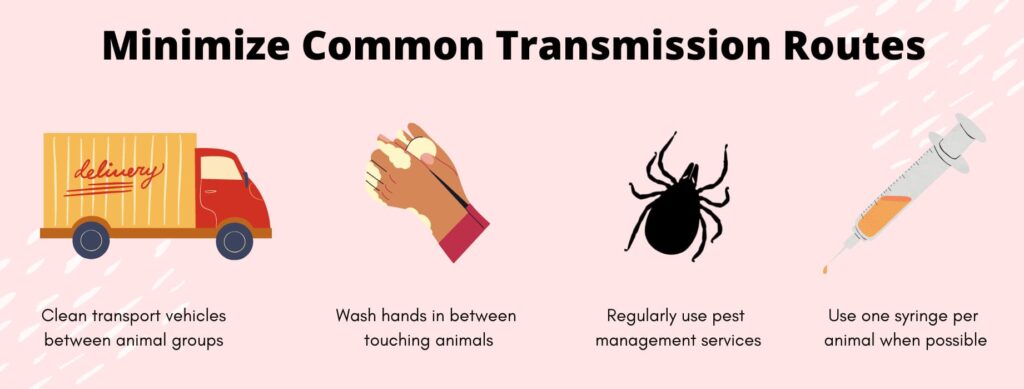Biosecurity Plan
“If You Fail to Plan, You Are Planning to Fail” — Benjamin Franklin
To facilitate smooth farm operations and ensure good farm biosecurity, it is important to have a plan. In this module, we will learn about why we need a biosecurity plan and how to create one.
- Evaluates biosecurity structures and practices of a farm
- Identifies the risk factors that threaten the health and productivity of farm animals
- Suggests ways to reduce the disease risk
An experienced swine producer can perform biosecurity assessment for their farm on their own or they can ask their veterinarian, another experienced swine producer, a biosecurity officer, or another appropriately knowledgeable person to do the assessment for the farm.
To assess biosecurity for your farm, you can use online and offline tools available for this purpose. For example:
These tools are basically questionnaires covering several aspects of farm production and management that are vital from a biosecurity standpoint. Based on your answers, it generates an assessment in the form of a biosecurity score for your farm.
Why is biosecurity assessment important?
Setting up farm biosecurity is a one-time event but maintaining it is a continuous process that needs to be evaluated from time to time to check for loopholes and voids in the system. A single glitch in the system can compromise the farm’s biosecurity and thus the productivity of the farm animals.
Are biosecurity assessments costly?
Biosecurity assessment is a cost-saving step that helps you identify the problem before it becomes too serious.
Secure Pork Supply (SPS) plan is designed for swine producers to ensure business continuity in the event of a foreign animal disease outbreak as well as protect the farm operations from endemic diseases. It aids in the issuance of animal movement permits when a FAD outbreak occurs near your farm or in your state to prevent inadvertent loss due to movement restriction.
NOTE: Given African swine fever is closer to the US borders than it has ever been in the last several decades, it is high time to adopt an SPS plan to safeguard farms and animals from huge loss.
Pre-requisites for getting a Secure Pork Supply (SPS) Plan:
- Premise identification number (PIN)
- Site-specific enhanced biosecurity written plan and its implementation
- Having a defined PBA and line of separation are most important
- Maintaining movement records of animals, personnel, visitors, feed delivery, animal transport trucks, equipment, and other items
- Record the name, address, and contact information for everyone entering the farm: logbook
- Biosecurity training for farm personnel
- Educating farm personnel about ASF, Classical swine fever, and FMD to facilitate disease monitoring.
- Facilities for sample collection: oral fluid, nasal swab, and blood
How to Get an SPS Plan
- Familiarize yourself with org
- Validate your premises; obtain a PIN; print a map
- Locate and compile records: Logbooks, Certificates of Veterinary Inspection (CVIs), and Standard Operating Procedures (SOPs)
- Write and implement an enhanced biosecurity plan
- Create and label a Premises Map
- Write biosecurity protocols to ensure accurate communication with employees, visitors, and delivery personnel
- Complete the Illinois Enhanced Biosecurity Checklist
- Foreign Animal Disease Training and Response: educate farm personnel to identify a FAD, know how to respond to a FAD outbreak, and are able to collect samples
Is biosecurity adoption cost-effective?
Not all biosecurity measures are expensive to implement like setting up fences, maintaining farm hygiene, cleaning and disinfecting farm premises and equipment, and manure and dead animal disposal. An enhance biosecurity plan requires an investment during set-up, but the cost varies with the size and type of farm in question. Undoubtedly, having a bio-secure farm is cost-effective in the long-run as it significantly reduces loss due to diseases and productivity losses. It also ensures business continuity in event of a disease outbreak in a nearby area.

Minimize the risk of transmitting disease through direct and indirect ways.
Is biosecurity a one-time process?
Although setting up biosecurity is a one-time event, maintaining a bio-secure farm requires continuous effort in the maintenance of biosecurity protocols and facilities on the farm. Keep the following points in mind for maintaining a bio-secure farm:
- Review and monitor all disease prevention measures regularly.
- Stay updated on any disease case or outbreaks in the area and adjust the biosecurity program to meet specific needs.
- Train new workers so they clearly understand the concepts of biosecurity and its implementation on the farm.
- Maintain dynamic communication between all farm employees to ensure biosecurity protocols are implemented and functioning smoothly through setting up regular farm meetings to discuss farm operations.
- Respect each individual farm’s biosecurity practices while visiting and enforce visitors in your farm to abide by your farm’s biosecurity protocols.
What’s Next?
Hopefully, now you all have a good understanding of how to protect your pigs’ health and your production from loss by adopting biosecurity according to your farm’s needs and requirements.
To learn more, check our resources tab.
